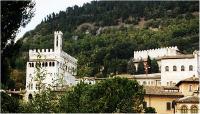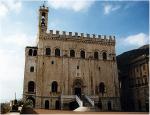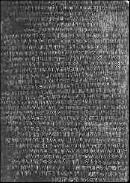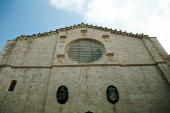
Gubbio -
Gubbio in the Middle Ages
 |
| Veduta di Gubbio |
Gubbio consolidated its importance as a city-state in the Middle Ages. In 1151 the city managed to stave off an attack by a league of neighbouring cities led by Perugia. Then in 1155 it avoided the humiliation of defeat at the hands of Frederick Barbarossa, who even granted Gubbio more privileges. Forever at odds with Perugia, Gubbio followed a different course of development than the other cities of the region, forging strong links with the Marches where it built the dependent cities of Cantiano and Pergola on the other side of Monte Catria. Its moment of greatest splendour is clearly apparent in the grandiose architectural complex of
Piazza della Signoria. The name has in fact been used improperly, since the square was built after the period when the city was ruled over by
signori. The square is built over an imposing sub-structure and is directly in the centre of the city, at the meeting point of the four quarters of Gubbio. At either end of the piazza stand the buildings that symbolise the free city-state,
Palazzo dei Consoli and
Palazzo Pretorio, or dei Priori. The former was erected between 1332 and 1349. An inscription on the architrave of the entrance attributes the design to Angelo da Orvieto, although on account of the clear stylistic differences with the Palazzo Comunale in Città di Castello (also designed by Angelo da Orvieto) some believe the project to have been strongly influenced by Matteo di Giovanello, known as
Gattapone da Gubbio.
 |
| il Palazzo dei Consoli |
The name Palazzo dei Consoli is also misleading, since the building was erected at a time when the city was governed by
priori and not consuls.
Even without the architecture of the surrounding square, Palazzo dei Consoli remains one of the finest examples of Medieval city architecture in Italy. Rebuilt in the last century, a suspended staircase that fans out in two directions leads up to the Gothic entrance on the first floor, allowing access to the workshops on the ground floor of the building. A frescoed lunette opens above the impressive Gothic doorway, which leads into the
Sala Maggiore. Used for gatherings with the people of the city, this enormous room measures 30.2 metres in length, 13.65 metres in breadth and 13.2 metres in height. It is said that the priori listened unseen to the conversations that went on during the meetings held by the people of the city through the openings that are visible in the barrel-vaulted ceiling.
 |
| Le Tavole Eugubine |
Today the Sala Maggiore houses the
Museo Civico, which also occupies the palazzo’s small chapel. The
Gubbio Tablets are exhibited here, along with some coins minted in Gubbio in the Umbrian period and during the time of the dukes of Montefeltro. The walls of the Sala Maggiore are decorated with some sarcophagi (one Umbrian, one Roman and the other Byzantine), as well as other archaeological finds and fragments and some coats of arms. The steep flight of steps is flanked by a 14th century fresco by an unknown artist depicting the ‘Madonna with Child, St Ubaldo and St Anthony’. An early 14th century fresco, now attributed to Mello da Gubbio but previously thought to be by Palmerucci, also adorns the chapel. The flight of steps leads to the upper floor which houses the
Pinacoteca Comunale. The collection is hung chronologically and offers a representative panorama of local art ranging from the late Middle Ages to the Baroque. The exhibits include some precious 13th century reliquaries, a crucifix by an artist close to Cimabue, a large poliptych by Guido Palmerucci, works from the school of Ottaviano Nelli (15th century), a banner by Sinibaldo Ibi (1503) and canvases by the Gubbio artists Virgilio Nucci and Felice Damiani. Two large fireplaces and some finely crafted furniture complete the collection. A loggia opens up on the valley side of the palazzo, offering a fine view over the city and countryside beneath.
The
Palazzo Pretorio (or dei Priori) stands at the opposite end of the piazza and rests on the same sub-structures that support both the piazza itself and Palazzo dei Consoli. Never finished, as can be clearly seen by the roughly-hewn corners, today this building houses the city authorities. A new section was added to the north side of the building in the early 19th century. The interior is composed of three large halls one above the other, whose large cross-vaulted ceilings are supported by a single central pilaster. Construction of the building was left unfinished on account of the city’s rebellion in 1350 against the attempt by the Gabrielli family to establish their rule. Between 1354 and 1371 the city nonetheless had to submit to the Papal Legate, Cardinal Aegidius Albornoz, and later in 1384 to the Montefeltro family of Urbino.
The northern perimeter of Piazza della Signoria is occupied in all its length by
Palazzo Tanghiasci-Brancaleoni. The building’s Neo-Classical facade conceals a series of different buildings. Two fake doorways are in fact openings into two streets than run through the palazzo. Within the palazzo itself there is a Roman mosaic. Crossing the palazzo, a series of Medieval alleys and covered walkways lead to
Via Ducale. On the right hand side of this streets stands the
Palazzo dei Canonici (14th century), with its elegant two-mullioned windows. Its cellars contain a vast 16th century barrel with a capacity of 2000 litres.
The area that was once the
platea communis was occupied by the city’s first public buildings, such as the Palazzo dei Consoli. Formerly the court of the Longobard dukes, this and a series of other buildings were incorporated into a building erected by order of Francesco Montefeltro Duke of Urbino between 1471 and 1474. Frequently attributed to the architect Francesco Laurana, who was also responsible for the design of the ducal palace at Urbino, it is more likely that the architect was Francesco di Giorgio Martini since Laurana was working for the Court of Naples at the time. The ground floor of the previously existing 12th century Palazzo dei Consoli was composed of a single vaulted hall known as
il voltone, now an open street that leads to a terraced garden looking onto the city below. The large first floor hall of the building was instead worked into two rooms of the
Palazzo Ducale, where there are still some fireplaces that resemble those in the ducal palace of Urbino. When the Montefeltro line expired in 1508, the della Rovere family reigned in their stead until 1621. The Montefeltro furniture collection was sold off for the most part, including the inlaid study of the duke now at the Metropolitan Museum in New York. Recently restored, the palazzo now houses the
Museo della Ceramica, which contains examples of Gubbio’s renowned ceramic production on a par with that of Deruta, Gualdo Tadino and Orvieto. The simple entrance leads to a supremely elegant courtyard that is remarkable for its proportions and for the combination of colours obtained from the variety of materials used. On the ground floor the courtyard is closed in by a loggia that runs along three of its four sides. One side is missing because of lack of space. The walls are decorated in alternate brickwork and stucco, with stone inserts. ***.
 |
| il Duomo |
Opposite the Palazzo Ducale stands the Duomo, dedicated to
St Mariano and St James. Rebuilt in Gothic style in the 14th century, the previous church was 13th century Romanesque. The facade is simple and contains an ogival entrance with a round window surrounded by the symbols of the four evangelists and the Mystic Lamb that had adorned the previous church. The Latin cross interior is punctuated by large ogival arches and contains a number of extremely fine works. A ‘Pietà’ by Dono Doni (after 1560) is in the fourth archway to the left. The sixth archway contains an ‘Adoration of the Magi’ of the
school of Pinturicchio, perhaps by Eusabio San Giorgio. A ‘St Mary Magdalene’ by Timoteo Vitti (1521), a collaborator of Raphael’s in the decoration of Santa Maria della Pace in Rome, is in the seventh archway. The eighth contains a ‘Madonna with Child Between Angels and St Ubaldo and St Sebastian’, a
fondo oro painting on wood by Sinibaldo Ibi (1507). The choir stalls, (1537) painted in fake marquetry by Benedetto Nucci, are particularly fine, as is the bishop’s throne carved by Girolamo Maffei in 1557, which stands to the left of the main altar. The altar itself rests on an ancient sarcophagus that contains the bodies of the saint to whom the church is dedicated. The fifth archway on the right hand side leads to Palazzo dei Canonici, which houses the
Museo del Duomo in what was once the refectory. The museum contains a 14th century altar piece by Mello da Gubbio, ‘Madonna in Glory Amongst Angels and Cherubs’, as well as a fine 16th century Flemish brocade pluvial with seven stories of the Passion, donated by Pope Marcellus II, formerly Bishop of Gubbio. There are also some detached frescoes taken from the crypt of the church of Santa Maria dei Laici and a 17th century ivory crucifix.
© Copyright 2001-2025
by Umbriaonline.com
SCG Business Consulting S.a.s. di Giacomelli E. & C. - Internet Advertising Division - © 2001-2025 All Rights Reserved - P.IVA 01675690562



